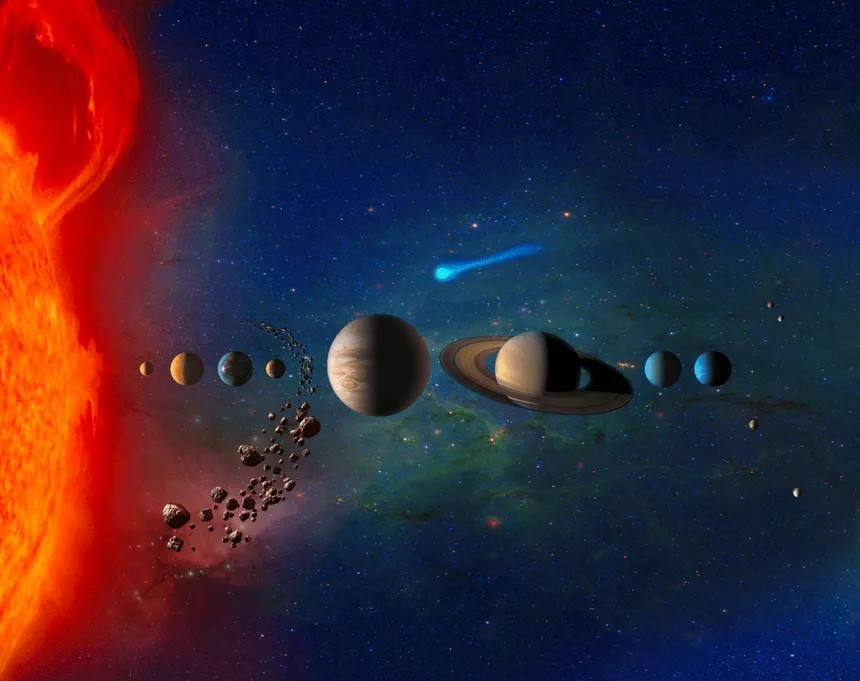 The Solar System: Interdependent Dynamics that Sustain Life on Earth
The Solar System: Interdependent Dynamics that Sustain Life on Earth
by Ashley Gorman-Sortland
In our large universe, one finds chaos and harmony at every turn; however, within our solar system, the same interconnected dance creates the conditions for life on Earth. The solar system, our neighborhood in the Milky Way galaxy in which we reside, shows interactivity between its planets, moons, debris, and the Sun that can be both beneficial and disruptive. Without these family dynamics, Earth may not have developed life or the ability to sustain it.
Earth occupies a premier position within the solar system habitable zone: “Earth is the third planet from the sun, the fifth largest planet in our solar system, with a radius of 3,959 miles, and the only world known to support an atmosphere with free oxygen, oceans of liquid water on the surface and life. Earth is one of the four terrestrial planets, according to NASA: Like Mercury, Venus, and Mars, it is rocky at the surface” (Harvey). In comparison, Venus, closer to our Sun, suffers from extreme heat. Further away, Mars experiences temperatures several hundred degrees below zero. Earth’s position is a result of the gravitational interactions between others in the system. While keeping Earth’s orbit stable, these interactions emphasize its dependence on the other members of the solar family (Center for Astrophysics).
Beyond the orbit of Earth, other planets and bodies significantly contribute to our system’s stability. Mercury, Venus, and Mars show a history of different growth and evolution affected by their masses and atmospheres. Mars once showed promise in the sustainability of life, but its small mass and gravitational field caused it to shed its atmosphere. Further out, Saturn, Uranus, and Neptune helped shape our gravitational framework by stabilizing planetary orbits and controlling what interactions occur among the other celestial bodies (Morbidelli, Nesvorný).
Jupiter’s role within the solar system is like that of a strong big sibling. Jupiter has been both protective of the Earth by deflecting comets and asteroids but also disruptive to the solar system as well. The Grand Tack hypothesis posits that Jupiter once made an inward migration toward our sun, altering the structure of our solar system and adversely affecting other planetary formations, especially Mars (How the Universe Works). Jupiter also has a huge effect on its own moons. Research has shown that Callisto, Europa, and Ganymede could be producing their own internal heating because of the tidal friction caused by Jupiter’s gravitational pull. Because of this, there could be potential for subsurface oceans and conditions favorable to life (Mace). All of this demonstrates the gravitational interdependence within planetary systems.
In addition, the Kuiper Belt and Oort Cloud are distant, isolated relatives of our Solar Family. From within them come the icy rocks and bodies that brought water and organic compounds to earth, influencing its evolution (Center for Astrophysics).
Earth’s early formation was marked by catastrophic and chaotic collisions frequently adding more and more material to the new planet. One major impact created our moon: “Many researchers think some large object crashed into Earth long ago, and the resulting debris coalesced to form our moon. It is unclear though if that colliding object was a planet, asteroid, or comet, with some scientists thinking a Mars-size hypothetical world named Theia was the instigator” (Harvey). A planet-sized body, Theia, collided into the newly-formed Earth, initially causing massive destruction. From that debris formed the moon we know today. The moon helps stabilize Earth’s tilt, creating the tides that our marine life relies on. It also helps moderate the changing climates which make our moon imperative for environmental stability in ecological crisis. Earth relies on the sustained stability and cooperation of the other planetary bodies to continue to support life (“Catastrophes that Changed the Planets”).
This understanding of the delicateness of our planet is helping contemporary researchers evaluate potential habitability in newly discovered exoplanets. They look for solar system-wide characteristics that mirror our own like the stability of the star, large protective gas giant planets with big gravity, and moon stability. So far, they have found nothing like Earth which emphasizes the uniqueness of our planet (Van den Heuvel).
Earth’s capacity to sustain life is not because of its own independence or isolation but its reliance on the extensive Solar Family. Every related dynamic from solar radiation to lunar orbital tilt as well as the wonders from the outer system have all contributed to the habitability of our planet. Over history, we have seen massive collisions and destruction followed by rebirth. Our solar system brings chaos and harmony, and its evolution shows how interdependence can create the conditions for life and help us know what to look for on our great search for extraterrestrial habitability and even extraterrestrial life.
Works Cited
“Catastrophes that Changed the Planets.” A&E Networks, 2011.
Harvard & Smithsonian. Center for Astrophysics, 2024.
Harvey, Ailsa. “50 Interesting Facts about Earth.” Live Science, 2024.
“How the Universe Works: Understanding the Grand Tack Hypothesis.” Science Channel, n.d.
Jakosky, Bruce M. “Mars’ Atmospheric History Derived from Upper-Atmosphere Measurements pf 28/Ar/36Ar.” Science, 2017: 1408-1410.
Mace, Mikayla. “Jupiter’s Moons Could Be Warming Each Other.” 10 Sept 2020. University of Arizona News, 12 March 2025.
Morbidelli, Nesvorný. “An Early Dynamical Instability Among the Solar System’s Giant Planets Triggered by the Gas Disk’s Dispersal.” Monthly Notices of the Royal Astronomical Society, 526.3 (2023): 3933-3945.
Van den Heuvel, Edward P. J. “The Amazing Unity of the Universe: and its Origin in the Big Bang.” Springer International Publishing, 2016
